Different Leadership Styles
You should be aware from experience of the wide variety of teams that exist throughout modern organizations. The remainder of this eBook will use three real-life examples of teams to illustrate how different team leadership styles can be applied to suit different types of team.
These same team examples have been used in our 'Team Building' eBook. If you are familiar with each one's size, function, and structure you can go straight to the 'Leadership Theories' section.
The example teams are:
• The Project Team
• The Customer Support Team
• The Strategy Team
Each of these teams is quite different in its purpose and structure, and has a different size, function, and composition.
They will illustrate that there is no 'best way' to manage a team and that you will need to use your own judgment and understanding of your organization when considering 'best' how to manage your own team.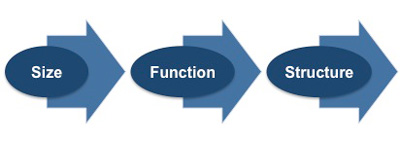 |
There are three practical leadership styles that you should be familiar with: Transactional Leadership, Transformational Leadership, and Situational Leadership.
All of these example teams work within a public utility company, a Water Company. They are based on real-life teams and are described in detail so that you can appreciate the differences between them and how these affect the way they are managed.
Background Information
These teams work within a large public utility company that was originally set up to provide water services. The company was originally owned by the state but has been privatized and now operates as a commercial organization.
The Water Services Watchdog is responsible for ensuring that it continues to provide a quality service to all its customers and offers 'value for money.' This body ensures also that the water company adheres to all the required legislative regulations.
In the past, the company has operated with a traditional authoritarian management style, but it is endeavoring to alter this to a more commercial and empowered style of management through its change management program. All managers are expected to develop, coach, and mentor their staff so that they adopt the competencies required by the new commercial organization.
Each of these teams requires a different type of leadership to make it successful. How and which style is best for you to adopt is discussed in the section 'Leadership Theories.'
Development Team Example
The IT department is headed up by a new director who has been brought in from a software company to update the organization's IT systems so that operations become more efficient and profitable.
Project Leader
In this scenario, you have been with the organization for five years and witnessed its evolution from a traditional water authority to a modern water company. You are currently a team leader and have just been given the responsibility of managing a key IT project for the next twelve months. You are responsible for ensuring that the project is delivered on time and within budget.
Project Objective
Your objective is to develop a suite of software programs to enable the company to monitor water quality throughout its catchment area. This will be a web-based IT system that allows water quality data collected from remote locations to be entered into a central database where it can be analyzed by the water quality department.
Composition of Team
The members of this team are all university graduates, their ages vary between 25 and 45 years, and they are all consider themselves relatively well paid. Five of the team members work directly for the company and three are freelance contractors.
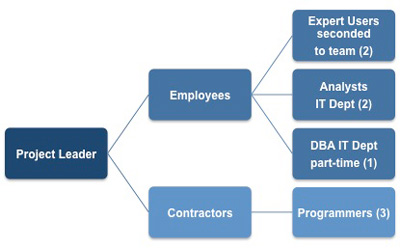 |
As you can see from the organizational chart above:
- The team has eight members excluding yourself
- Five of them are company employees
- Two have been seconded to the project from the water quality department
- One member, the database analyst, is only available to the team on a part-time basis
- Three of the team are external contractors
The first thing to notice about this particular team is that it is operating under what is known as a Matrix Management Environment. The expert users belong to the water quality department and the analysts and the DBA belong to the IT department. They are only assigned to you for the duration of the project, and when it is completed they will return to their respective departments. You do not have any direct control over them outside of the day-to-day running of the project. They still report to their own line managers, who are responsible for their appraisals, remuneration, promotions, etc.
The freelance contractors are all independent workers who have contracts with the company for the expected duration of the project. They have all worked for the company on previous projects and are keen to add another successful project to their resumes.
Customer Support Team Example
Customer Support is one area of the Customer Services department, which is managed by the Customer Services Director who has been with the organization for over twenty years. His role has two main objectives relating to customer service:
1. To ensure customer complaints are resolved quickly and to both parties' satisfaction.
2. To ensure the number of complaints referred to the watchdog are minimized.
Customer Support Manager
In this scenario, you have been working in the customer support area for three years and have recently been promoted to Customer Support Manager. You are responsible for ensuring that:
• Calls received by the support desk wait no longer than five minutes to be answered.
• 90% of issues are resolved on the first call.
Composition of Team
Your team is a group of 22 permanent members of staff who all report to you. The age of your team ranges from 16 to 28 years, with 18 of the staff being under 24 years. Ten members of the team are graduates and only seven members of the team have been with the organization for six months or more.
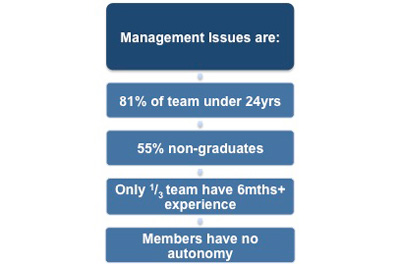 |
The team members have virtually no autonomy over their work because their workflow is handled by an automated telephone system which routes queued calls to the first available team member.
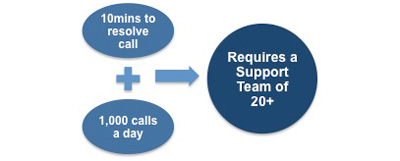 |
The average time it takes to deal with a call is ten minutes and the average number of incoming calls per day is one thousand, which means that the team needs around 20 members to handle demand.
Steering Team Example
Many corporations make use of Steering Teams in their drive to stay ahead of competitors, research future market trends, and plan for changes in legislation that will affect them. Organizations that operate in highly regulated sectors also use this type of team to consider the impact of new rulings on the business.
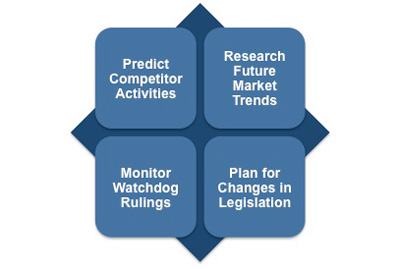 |
Steering Team Leader
In this scenario, you are the Business Development Executive of the water company. You have been an employee for two years. Your previous experience includes commercial legal expertise and management of deregulation in the leading telecommunications corporation. Your team's long-term objective is to identify the most profitable business opportunities that are available to the water company following the deregulation of their operations. The legislation removes the restrictions that previously meant that the organization could only sell water services.
The team also has a short-term objective to present a report on the potential opportunity and profitability of selling insurance to the water company's existing customer base of 14 million households.
Composition of Team
The Steering Team has some permanent members and some who have been brought in to look at specific issues. The permanent membership is made up of a senior person from each department within the company and the function of this group is to identify new business opportunities as described earlier.
In order to evaluate an opportunity, the team leader will need to bring in additional expertise from both inside and outside of the company.
For example, when investigating the possibility of selling insurance to its customer base the Steering Team would need to bring in representatives of:
• Customer Services Department
• IT Department
• Finance Department
• Regional Directors
• Marketing Department
• Law Firm
• Potential Partner Insurance Company
• Insurance Watchdog
This is a total of seventeen people as shown in the diagram below.
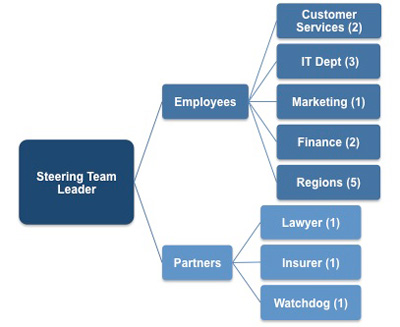 |
Each team member has his or her own responsibilities and career path, and even the permanent members of the team are only assigned to it on a part-time basis. Your team size of seventeen people is on the large side but it is necessary to have all the departments and partners represented who could be impacted by the decision to sell insurance. An informed decision simply cannot be made without involving all of these parties.
You may also be interested in:
Team Leadership Theories | Leadership Theories and Management | Transactional Leadership | Transformational Leadership | Situational Leadership | Leadership Continuum.


